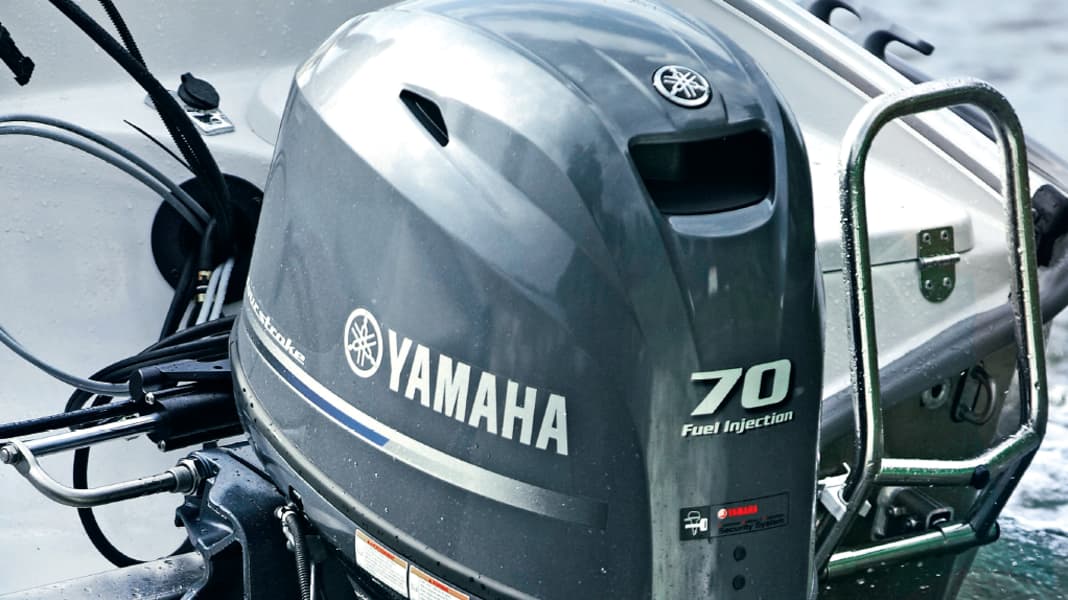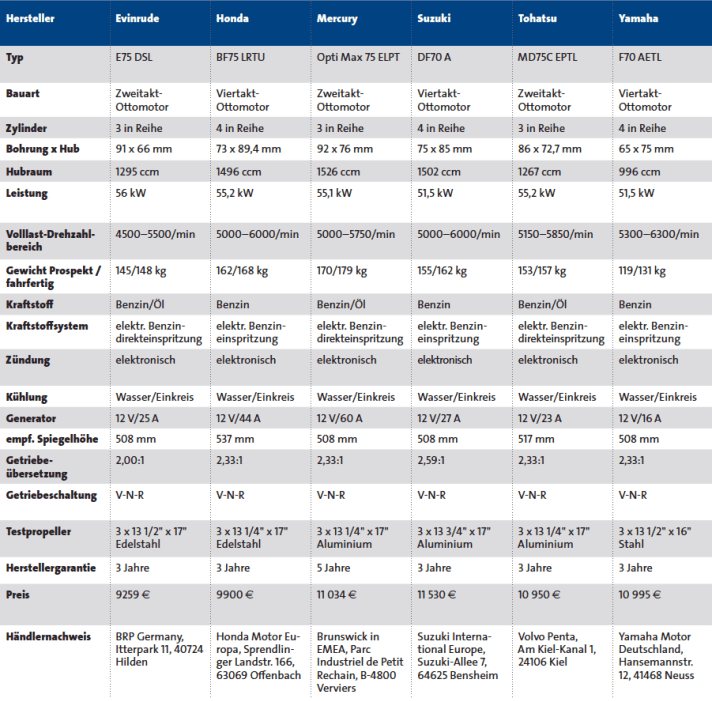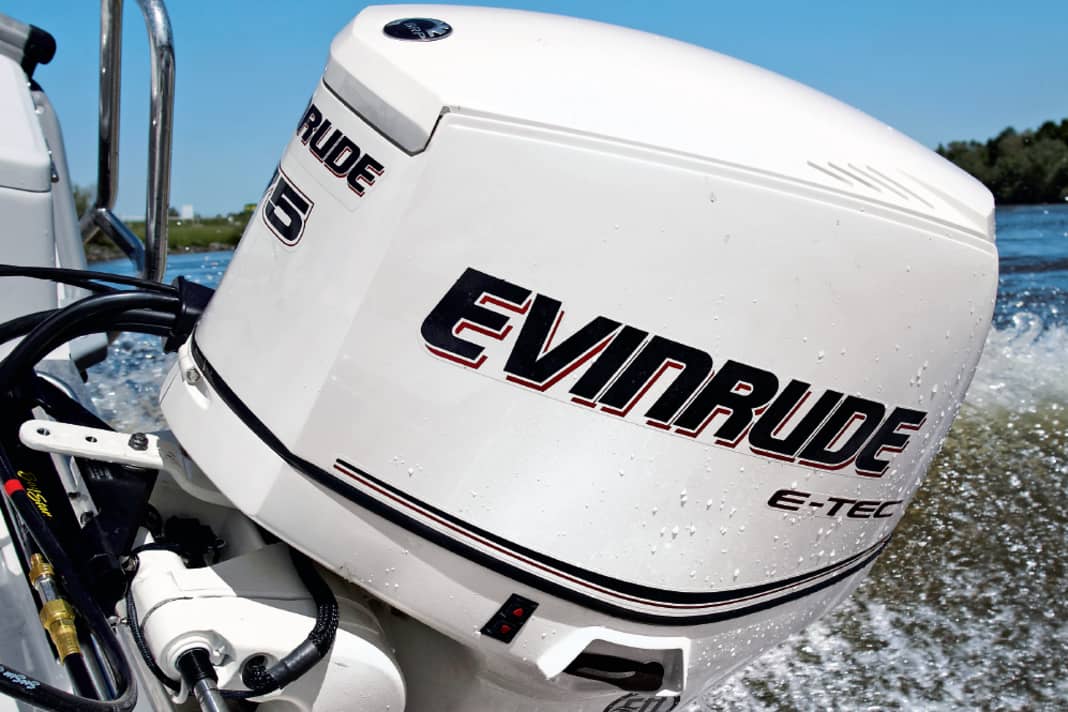







The above engines are used on RIBs, small cabin cruisers and open sports boats in the 5 and 6 metre class. The test transom, to which we attached Evinrude, Honda, Mercury, Suzuki, Tohatsu and Yamaha engines, belongs to a Silver Hawk 540 CC. This is an open centre-console boat with an aluminium hull and GRP interior. The standard built-in tank holds 105 litres of fuel. According to the shipyard, the 5.40 metre long boat without engine weighs 520 kg. The maximum motorisation stated on the CE plate is
74 kW, which corresponds to 100 hp. This puts us in the midfield in terms of performance in our engine test. You can read the boat test of the Hawk 540 CC in one of our next issues.
Since the middle of last year, the 75 hp outboard class has seen a new addition. With the Tohatsu MD75C, the Japanese engine manufacturer revised its product range (and at the same time our list of test candidates). Tohatsu took the older MD70B as the basis for the revision. This means that a total of six engines are on the test bench. Half of them are two-strokes, which are often still considered loud and smelly. Among the four-strokes, there are two engines with 70 hp, all others deliver
5 hp more.
In addition to the top speed, we measured the weight, fuel consumption and noise level. The first thing we realised was that today's two-stroke engines are not always the lightest. None of the competitors came close to the minimum weight of 131 kg of the four-stroke Yamaha F70. We always measure the ready-to-run engine, i.e. with oil and propeller. The Evinrude weighs a whole 17 kg more as the second lightest. Third place goes to the two-stroke Tohatsu with 157 kg. The Mercury OptiMax emerges from the comparison as the real heavyweight with a measured 179 kg.
To explain the difference of a whole 48 kg between 1st and 6th place, take a look at the "family tree" of the engines. The Yamaha with its 996 cc displacement only has "smaller brothers", namely the F50 and F60. With the exception of the Mercury, all the others are slimmed-down 90 hp engines. The "Black", as Mercury is also known due to its deep black colour, comes from "even higher up". The two-stroke engine with supercharger and direct injection delivers up to 125 hp. In any case, it has been proven that four-stroke outboards are not necessarily heavier than their two-stroke competitors.
Control electronics work under the bonnet of all engines. This is not only intended to reduce fuel consumption (and thus pollutant emissions), which is realised with an optimally calculated injection quantity, ignition and injection timing, but also to increase user-friendliness and operational safety. In the two-stroke engines, the electrical system also controls the lubrication of the numerous bearing points by the central lubrication unit.
The owner of an Evinrude E75 can instruct the latter to winterise the engine via the circuit. In this special programme, the engine injects more oil for preservation and then switches itself off. If it is then restarted in the spring, less oil should be injected initially so that the "preservative oil" burns off without leaving any residue.
For the purpose of operational safety, warning systems take on the task - for example, in the event of loss of oil pressure (four-stroke engines) and lack of oil (two-stroke engines) - of signalling both acoustically and visually. A warning is also given in the event of overheating. The systems have been developed and integrated to such an extent that they actively intervene in engine management in the event of danger to the engine. In the event of overheating, the engine speed is reduced in addition to the alarm; if the temperature continues to rise, the electrical system reduces the engine revolutions again.
The mixture preparation in all engines reacts very sensitively to impurities in the fuel. The installation of a fuel filter with water separator should be mandatory in every boat, as the fuel filters alone on the engine are not sufficient. The electronic high-pressure petrol pumps and the multi-point injection nozzles on four-stroke engines work together to ensure the best possible atomisation of the fuel. Evinrude, Tohatsu and Mercury inject the petrol directly into the combustion chamber, where it is ignited.
We recommend running the engines on premium petrol (or better fuel); even if all models are suitable for E10, the often long service life speaks against its use. Interesting for captains in faraway countries: The lower octane limit for engines, with the exception of Mercury, is at the level of normal petrol (91 octane), with the Americans even 87 octane is sufficient.
If the machines have everything they need (good fuel and 12 V), you only have to turn the ignition key briefly and off you go. In other words, they start easily both cold and warm and run smoothly straight away. It goes without saying that there are no clouds of smoke or fumes in 2013. The keyword "comfort" includes idle speed control, multifunctional instruments for engine speed, trim, battery voltage, operating hours and fuel consumption and the power trim tilt facility.
With the latter, the motor can be raised to the water surface and lowered again at the touch of a button. When travelling, it does not go quite as high; the tilt angle is then automatically limited to the trim range. This usually allows the boat to be brought into the best trim position with ease. Easy-to-read instruments show the position of the engine.
PART 2 WITH THE TEST RESULTS OF ALL SIX OUTBOARDS YOU CAN FIND HERE.

